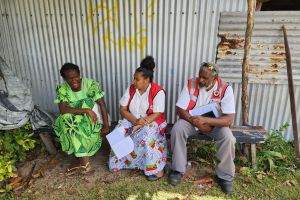In October 2023, the Canadian Red Cross used its International Disaster Relief Fund (IDRF) to fund the deployment of Operations Officer Mark McCaul to support our International Federation of Red Cross and Red Crescent Societies (IFRC) colleagues in Fiji during cyclone season.
The IDRF is a flexible fund utilized to respond to emergencies internationally, particularly in responses that receive low levels of international support due to minimal public or media uptake.
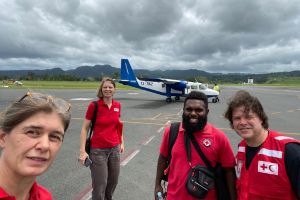 Donations to the IDRF are not emergency specific and allow us the flexibility to quickly support communities around the world impacted by different emergencies. This includes rapidly sending relief items, humanitarian experts, and funding directly to the ground. While Mark was working in Fiji, Tropical Cyclone Lola made landfall in Vanuatu causing widespread damage. The flexible funding through IDRF made it possible for Mark to later support in Vanuatu where the needs were greater. Below, Mark has shared an account of his experience:
Donations to the IDRF are not emergency specific and allow us the flexibility to quickly support communities around the world impacted by different emergencies. This includes rapidly sending relief items, humanitarian experts, and funding directly to the ground. While Mark was working in Fiji, Tropical Cyclone Lola made landfall in Vanuatu causing widespread damage. The flexible funding through IDRF made it possible for Mark to later support in Vanuatu where the needs were greater. Below, Mark has shared an account of his experience:I had the amazing opportunity to be deployed as part of Canadian Red Cross’ international emergency response team for three months in the South Pacific—a region of stunning natural beauty with beautiful blue oceans, great weather, vibrant nature, and warm people. This region, like many others the Canadian Red Cross seeks to support, is prone to disasters such as earthquakes, tsunamis, volcanic eruptions, cyclones, and droughts.
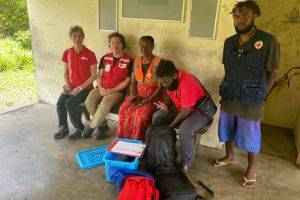
The process of preparing for cyclones is one that I hadn’t been overly involved with prior, but it is one that substantially improves the ability to save lives, minimize time taken between impact and first response, and fill the gap between international attention and needs on the ground. I only had a few days to get over jet lag and learn the ropes at the Fiji office before Cyclone Lola arrived and preparedness planning was quickly replaced with response planning.
Day 0: The calm before the storm
Day 0: The calm before the storm
The first thing I learned is that cyclones have a life of their own and a tendency to be unpredictable, both in timing (they can happen out of season) and in trajectory.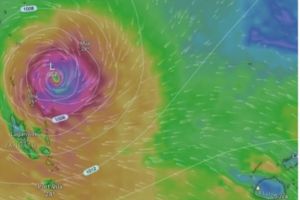 Predictions are helpful to strengthen preparedness and are formed based on lived experiences, formal education, word of mouth, and now the ever so handy Windy— an online forecasting tool that displays current and predicted wind formations across the globe. Beyond the categorization of the cyclone between 1 and 5 and general pathways that vary on an hourly basis, there are also many other factors that need to be assessed to be as prepared as possible to respond in the aftermath of a cyclone. While the cyclone is occurring there is not much you can do until it passes, and the next phase begins by linking the predictions and assumptions with the stories and realities of the people and populations that need to rebuild. This is often made possible thanks to the invaluable and amazing Red Cross and Red Crescent volunteers.
Predictions are helpful to strengthen preparedness and are formed based on lived experiences, formal education, word of mouth, and now the ever so handy Windy— an online forecasting tool that displays current and predicted wind formations across the globe. Beyond the categorization of the cyclone between 1 and 5 and general pathways that vary on an hourly basis, there are also many other factors that need to be assessed to be as prepared as possible to respond in the aftermath of a cyclone. While the cyclone is occurring there is not much you can do until it passes, and the next phase begins by linking the predictions and assumptions with the stories and realities of the people and populations that need to rebuild. This is often made possible thanks to the invaluable and amazing Red Cross and Red Crescent volunteers. During my first week in Fiji, our team began tracking Tropical Cyclone Lola and its approach to Vanuatu using Windy to map which path was most likely. 48 hours before making landfall, it was clear that the cyclone would have a significant impact on the population living in the Northern islands. We continually compiled and then updated (almost hourly) as much information as possible to answer these questions: How many people would be affected? Which seaports or airports would be affected? Would it pass rural or urban centres? Was there a road to communities in that area? Where was the nearest stock? Will there be communication or internet? Are we ready to apply for funding? Are our procedures up to date? What is the line of communication internally? Externally? These and others were all important considerations.
During my first week in Fiji, our team began tracking Tropical Cyclone Lola and its approach to Vanuatu using Windy to map which path was most likely. 48 hours before making landfall, it was clear that the cyclone would have a significant impact on the population living in the Northern islands. We continually compiled and then updated (almost hourly) as much information as possible to answer these questions: How many people would be affected? Which seaports or airports would be affected? Would it pass rural or urban centres? Was there a road to communities in that area? Where was the nearest stock? Will there be communication or internet? Are we ready to apply for funding? Are our procedures up to date? What is the line of communication internally? Externally? These and others were all important considerations.Day 1 – 7: Adapt, adapt, adapt!
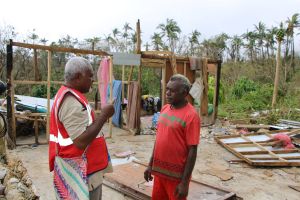 Striking the balance between the absence of information and the urgent need to respond with a plan is an art that requires flexibility, constant communication, and collaboration with a wide range of stakeholders… and the ability to adapt quickly.
Striking the balance between the absence of information and the urgent need to respond with a plan is an art that requires flexibility, constant communication, and collaboration with a wide range of stakeholders… and the ability to adapt quickly. It is this component of coordinating or managing emergency operations that I find one of the most challenging and rewarding. Properly representing or “translating” the realities and stories from colleagues and affected populations into an Operational Strategy and budget dramatically increases the efficiency of any operation.
In the days following Cyclone Lola, coordinating, compiling, extrapolating, assuming, filtering, communicating, and writing information and data into tentative plans and budgets was the primary objective from Fiji. This activity took place, as is often the case in emergencies, with extremely limited information and data, as well as limited to no capacity to communicate with the people directly affected. The result of the process is the publication of an IFRC Emergency Appeal, the mechanism that facilitates the provision of funding and other important supports and resources. It also serves as a communication tool with stakeholders and donors across the globe.
Day 8 – 30: Hit the ground running
It is always a revealing test of accuracy to compare dashboards and strategy narratives to the realities that are unfolding in “real life” in the field.Following the initial week in Fiji, I was able to travel to Vanuatu to support the Vanuatu Red Cross Society (VRCS) with their relief efforts. The VRCS was already in the process of distributing relief items and were immediately extremely supportive with the many questions that I had. Stepping into any new context there are always a lot of questions— questions that provide context to the data sets, clarity on budget lines, and some just because of new situations never encountered before. These questions often lead to the amazing stories of resilience, perseverance, dedication, and humanity represented in the first-hand accounts from those affected, including volunteers and staff in areas impacted by the cyclone.
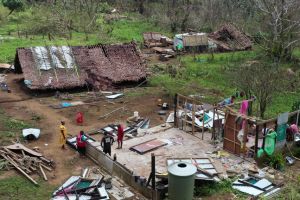
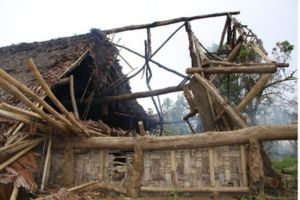
Since being in Vanuatu, I have also experienced a mild earthquake, and received Tsunami warning messages on my phone - a constant reminder of the continued challenges and importance of preparedness planning and support in risk mitigation. It has been a privilege to work alongside the teams here. In reflection, I look forward to being engaged a little bit more and a little bit earlier to further streamline the preparedness process.
During crises like Tropical Cyclone Lola, we rely on the flexible funding provided by our donors through the International Disaster Relief Fund (IDRF). Donations to the Canadian Red Cross IDRF help provide people impacted by disasters with urgently needed food, shelter, first aid, basic health care, and medical supplies. The funds allow us to respond within hours of an emergency, well before any money has been received from supporters. It also allows us to implement disaster preparedness programs to create stronger and more resilient communities.


